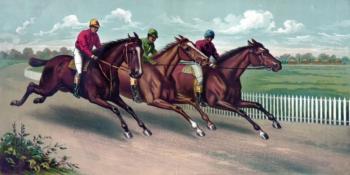Gambling With Dice in Tudor England
Posted: April 30, 2020
Updated: May 10, 2023
Without a shadow of a doubt, gambling with dice was probably the most popular Tudor game of all. Now the government was in a constant war against the gambling of dice and tried time and again to limit the places and times when these games could be played. Their main concern wasn't some quaint religious reasoning. But because from around 1512 t the end of Queen Elizabeth's reign, in 1603, regular archery practice was seen as a perquisite of medieval life. There was genuine concern that the "lower" orders were letting the gaming with dice take over these important skills.

Image source: Royal Collection via Wikimedia Commons
Introduction: Gambling with Dice in Tudor England
Finally, in 1542, a governmental act of law was passed against popular games, including gambling with dice. It stated that no artisan, husbandman (a small farmer of a lower status than yeoman), laborer, fisherman, water-man or serving-man could play tennis, quoits, bowls, skittles, dice or any other unlawful games with the exception of Christmas time. Tavern games like “shove-a-penny were also banned. Looking at the number of times these laws were broken gives us the idea that they were not so well enforced. As you can imagine, this ordinance was more especially important among the soldiers and sailors. These men, with plenty of “downtime” were forever gambling with dice. This here was an example of the orders issued to the garrison at Berwick castle in 1560:
“No soldier to use dice or cards for money except within the twenty days of Christmas. Or else at any of the gates of the town, or within the watch-houses, market-place, or Tolbooth, under pain of three days imprisonment, and the stakes to be forfeited to the Queen’s bridge at Berwick.”
Dice in Tudor England: Rules for Playing
The rules for gambling with dice haven’t really changed much over all these years. The most popular dice game in the 16th century was called “Main”. Essentially, the players put their wagers into a betting pool. The dice would then be rolled any number of times and the final scores tallied up. The aim of the game was to be as close as possible to the number 31. If the player went over the number, then they were out of the round. The one winner would take the whole pool, providing they were the closest and didn’t exceed the number 31. Unfortunately, online casino sites in the US serve different kinds of games nowadays.

The dice themselves were made from bone, ivory, or silver. They could be played on a board marked with diagonal lines, with the location of the dice affecting the scoring of the game. But, as you might imagine, there was a huge problem with the playing with weighted dice. Here’s a typical indictment from February 1556:
“Edward Wylgres…fishmonger enticed… Thomas Pratt gentleman into playing unlawful and prohibited games… Wylgres having with him in his left hand false dice that at every fall of the dice came forth at his pleasure; and that by secretly removing the true dice and play with these false dice, Edward Wylgres despoiled and defrauded Thomas Pratt of … four shillings and fourpence.”
Such was the heavy nature of the problem of gambling with dice and weighted dice in particular, that parliament was forced to act. In 1604 it passed a statute that prevented their manufacturing or sale.
High Society Didn’t Care For Laws
It goes without saying that the passing of laws was not to effect the upper echelons of society. There were absolutely no restrictions on gambling with dice. Many fortunes were both made and lost at this level. For example, The Duke of Buckingham once lost more than £76 to the Duke of Suffolk. To put this in perspective, a gentleman not at court could live very comfortably with just £20 per anum. Henry VIII was a huge fan of dice. His accounts show regular amounts of money being paid out for dice game losses. These include £45 to the Duke of Norfolk at Christmas 1529. There’s also an entry for £22.10 shillings to the sergeant of the wine cellars for money which the King managed to lose.
Gambling with Dice in Tudor England: Huge Gambling Debts
King Henry VIII loved to be gambling with dice. In fact, during the period between 1529 and 1532, Henry managed to lose a staggering £3,243, 5 shillings and 10 pennies to gambling debts. Measured in today’s money, the amount falls to around £52 million. When his daughter Mary was married in 1518, large bowls of both money and dice were placed on tables so guests could play. Unfortunately, Mary, just like her dad, wasn’t a good player either. She grew up to be a frequent but terrible gambler. There are many records and references to her losses at dice, cards, and bowls.
One of the most famous games of dice from the period was that which involved two of the husbands of Mary Queen of Scots. Her second husband, Lord Darnley played dice with her to-be third husband, the Earl of Bothwell. It is generally believed that the latter had the former murdered and that they were gambling with dice on the very night of his demise.
Click here to visit the Bovada Casino to find authentic casino games












